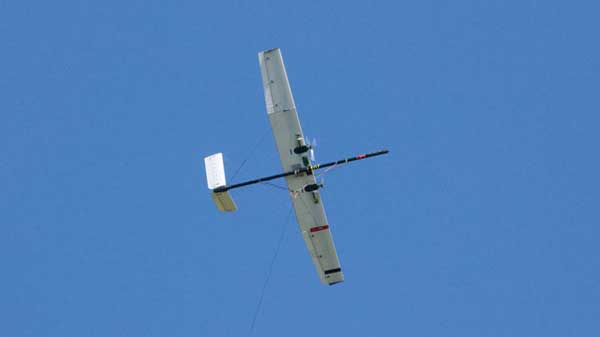Flying Turbine Lifts Wind Power

WASHINGTON — Makani Power's flying power generator began with a simple question: If almost all wind power comes from the very tip of a windmill's rotor blade, can one build a turbine that is just the tip? The solution, it turned out, involved cross-breeding a conventional windmill with a model planes.
Displayed here yesterday (March 1 ) during the ARPA-E Energy Innovation Summit, Makani's flying turbine, which stays aloft on a carbon-fiber wing, would generate power by harvesting wind through special blades that double as engines. When the wind blows strong, the turbine's wing effortlessly floats aloft, while gusts spin its power-generating rotors. And when the zephyrs ease, the rotors switch into plane engines, keeping the device in the sky until the breeze picks up again.
“To get energy, you need to interact with a lot of wind,” said Damon Lind, an aerodynamicist and systems engineer with Makani Power Inc., a 5-year-old company based in Alameda, Calif. “With a traditional wind turbine, you need a lot of mass to cover all that surface." The flying-wing-shaped kite "is the cheapest way to interact with that area.”
Each energy-generating section weighs only 100 pounds; two of those turbine sections sit on the larger kite. The kite, tethered to the ground by a power cable that transmits the electricity, flies into the wind at around 1,600 feet (487 meters), or about the height of a radio tower. At that altitude, the kite can capture the high-speed winds that regular turbines can't reach.
Aside from the cost and height advantages, the Makani kite would trump regular wind power turbines by generating electricity in slower winds and with greater efficiency. Whereas normal wind turbines require winds of at least 24 mph (38 kph) to produce a spark, the kite could pump out power during much more common 20 mph (32 kph) winds. Plus, the kit converts 60 percent of that wind power into electrical energy, compared with the 30 percent rate for conventional windmills.
But the kite's greatest advantage emerges when it deploys over water, Lind said. Offshore wind power delivers the most bang for the buck, but the farther offshore one builds, the more expensive it is to construct regular turbines, and turbine blades must become smaller relative to their energy-producing base. Since all the kite needs is a tether and a soft place to occasionally land, it can deploy far offshore at no additional cost or loss of efficiency.
Since replacing carbon-emitting energy sources with green technology requires that the new energy sources keep their costs down, this could be the low-cost solution that helps wind power leap ahead in the energy game. So far, however, Makani has tested only smaller versions of the kite and has yet to work out some of the aerodynamic issues likely to face the full-scale, energy-producing version.
Sign up for the Live Science daily newsletter now
Get the world’s most fascinating discoveries delivered straight to your inbox.
The ARPA-E (Advanced Research Projects Agency-Energy) summit, a U.S. government effort to promote advanced-energy development, concludes today.
This story was provided by InnovationNewsDaily, a sister site to LiveScience.









